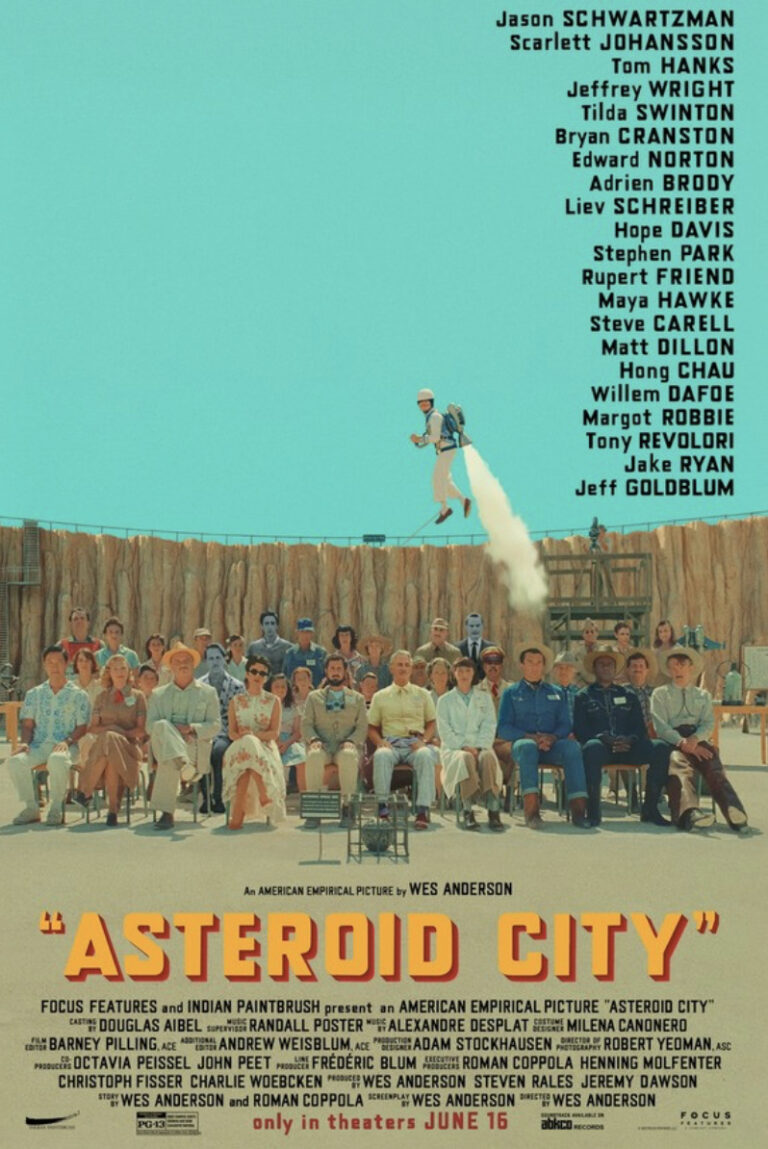
Synopsis : The itinerary of a Junior Stargazer/Space Cadet convention (organized to bring together students and parents from across the country for fellowship and scholarly competition) is spectacularly disrupted by world-changing events.
Rating: PG-13 (Some Suggestive Material|Smoking|Brief Graphic Nudity)
Genre: Comedy, Drama, Romance
Original Language: English
Director: Wes Anderson
Producer: Wes Anderson, Steven Rales, Jeremy Dawson
Writer: Wes Anderson, Roman Coppola
Release Date (Theaters): Wide
Box Office (Gross USA): $10.3M
Runtime:
Distributor: Focus Features
Production Co: Focus Features, Indian Paintbrush, American Empirical Pictures
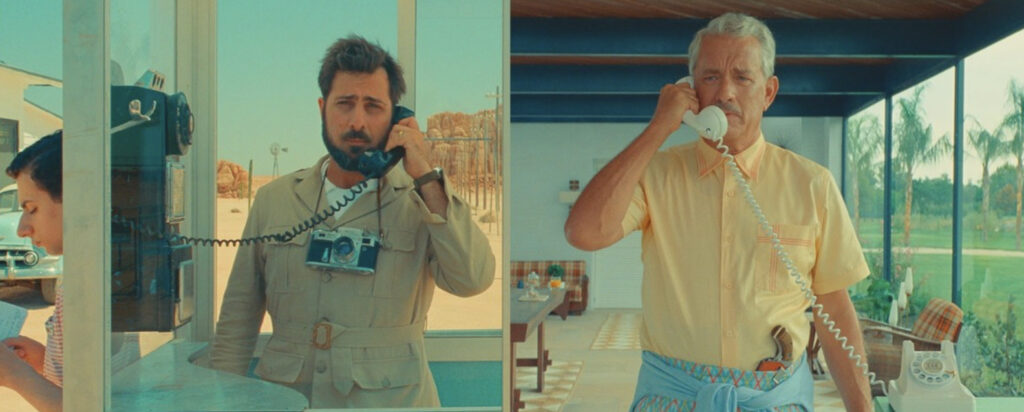
Press Conference with Writer/Director Wes Anderson, Actors Tom Hanks, Scarlett Johansson, Jeffrey Wright, Jason Schwartzman, Rupert Friend, Hope Davis, Bryan Cranston, Adrien Brody, Maya Hawke, Stephen Park, Jack Ryan
Q: Mr. Anderson, how did you come up with the idea of “Asteroid City?” What’s the basis for this?
Wes Anderson: The quick answer would be that for me starting a movie, starting to write a script, there’s usually not an idea for it. It’s a couple of ideas, two or three things. I would say for this one, the three ideas were one. Roman Coppola and I created this thing together. We wanted to write a part for Jason Schwartzman at the center of a movie that would be something that hadn’t been done before. So that was number one. That’s the beginning and we didn’t really know what it was, but we had a few notions about what this character was going through. The second thing was that we were interested in the setting of 1950s New York theater [world]. It was one golden age of Broadway in this case, sort of the Actors Studio variety of it.
The other thing was we thought we had to tell [was] a story of the play they’re putting on. And in the original thing there was a play called Automat and it was going to all be in this Automat. Then we started with the automat, but it was too little, too small. So we expanded it to the desert. Then it became something like this interaction of a black and white New York stage and color Cinemascope. I love Western cinema, and this kind of story and everybody’s both an actor in the role they’re playing, but there’s sort of another thing too and they kind of mix together. That’s how I got the idea for all of the things.
Q: Jason, when did you get involved in the process? You’ve obviously worked with Wes before — you go way back. Does he come to you with these kinds of fragments at first or with a completed script?
Jason Schwartzman: I remember it was July of 2019, July 11th, 2019. It was my anniversary and I was going with my wife, but he was calling. So we pulled over and he told me, “You know what, I’m sure everyone gets excited to hear I’ve got an idea for something. I’m working on it with Roman. I can’t tell you much, but we have an idea for you, for something, and we’re going to work on it. We’ll get back to you when it’s more completed, but you should be excited.” It was really nice, that’s really rare, a nice thing to get and it really carried me through for a while because that was the very beginning. “I guess I was telling you just to keep in touch about availability and not just to tease you about it but to make sure, just let me know what you’re going to do because we need you when the time comes.” And I pretended, I was like, “OK, wait…”
Q: There are two categories of actors — actors who have never worked with Wes Anderson that are dying to work with him and actors that have worked with Wes Anderson that are waiting for the call to return.
Wes Anderson : Wow. I thought the second one was definitely going to be “will never die” circumstances. That’s the third category. Never said no. “Yes. Okay.”
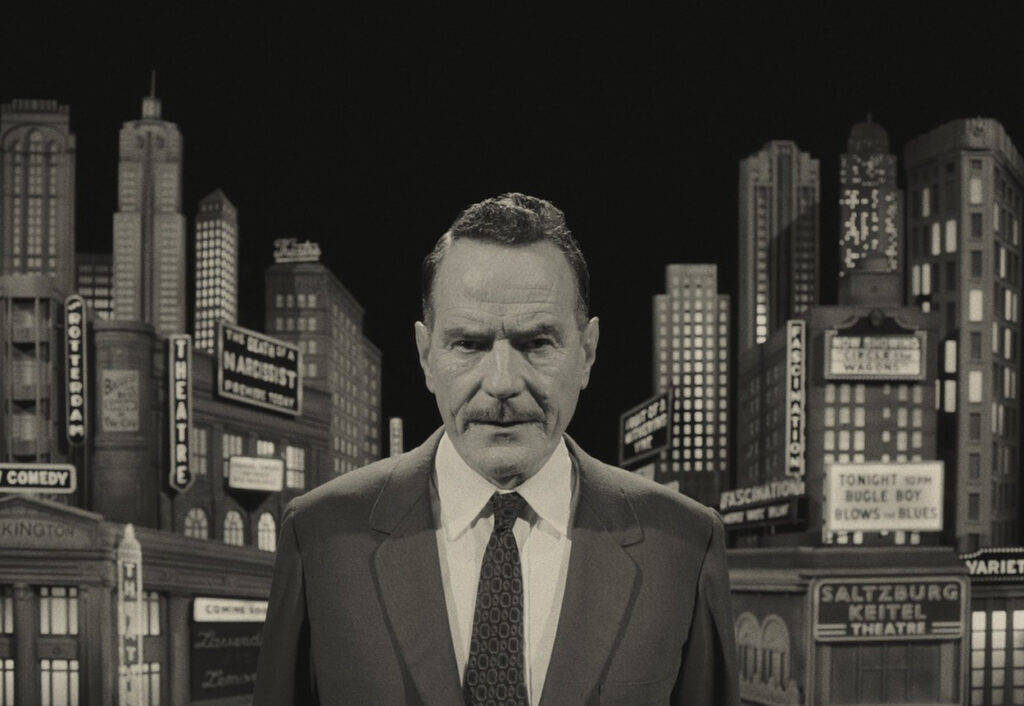
Q: Tom, did you always want to work with Wes?
Tom Hanks: I met Wes at a restaurant in Rome about, I’ll say 15 years ago, it was a long time ago, Ed Norton. I don’t know, we’re having dinner at this place in Reno. Yes.
Wes Anderson: In the Lito at the bottom of the Spanish steps with a green neon.
Tom Hanks: We were just there. I might have been working anyway, this sounds like a movie from the 1960s. We were there and part of it was that Wes Anderson [was there]. I would imagine gold and pompous or smoking a pipe kind of like what you did. We just talked about [nothing], we didn’t talk about anything at all. I don’t know if I said at that point, “Hey, come on, man, let me get into that rep company of yours.” This came about literally because of a lovely email that said, “We had met since then and would you like to come and join us?” I said, sure.
What is odd is that he sends you a version of the movie that doesn’t really need you —the animatic of the film that he put together. I thought this was your voice part of it because I know you collaborate so much. It was all just so you’re saying that you see a complete animatic version of the movie which I saw and I called you up. I said, “Well, I’m in but I don’t see how you need anybody to do this now because just the animatic is going…” Wes Anderson “Well, I got you, you screened it on a big screen?” I don’t know if it was meant for that. It looked like beauty and the beast to us. The role was great. I think you used the reference. We were looking for a retired Ronald Reagan type.
Q: You have the script, you have the Animatics, you have Wes here. What surprised you most when you saw the finished film? What surprised you when you finally sat down in the theater and saw the final version?
Bryan Cranston: It’s a nice surprise. I remember writing to Wes a little earlier after he had finished —after we had finished the film and said, “How are you feeling about it?” Quite honestly, Wes said, “I think it might be a really nice poem. I don’t know about [it as] a film just yet because I was still in the throes of post and editing.” He was still trying to figure out where it was going. But I think it’s the animatics that really allows us to see where it’s going and the type of characters that he’s imagining. We can only get a glimpse into the head of Wes Anderson, we can’t live there. That’s his domain.
Q: For newcomers to the ensemble — it’s probably on the list to work with Wes Anderson — so Maya, Rupert, and Steve, when you see the film, does it feel approximately what the experience was like?
Stephen Park: Or is that a whole different, beautiful realization of everything that Wes has prepared us? Wes started by sending pictures, images and the soundtrack, the train to San Fernando and then the animatics. To actually see the film, it’s so mind-blowing. I saw it first with my wife and then saw it again at Cannes, the second time, and I felt like I hadn’t seen it before. There’s so much [there]. I was really struck emotionally the second time in a way that I wasn’t the first time. I feel like I’m looking forward to seeing it again tonight because I know I’m going to see all these new things, but there’s so much to savor in this movie.
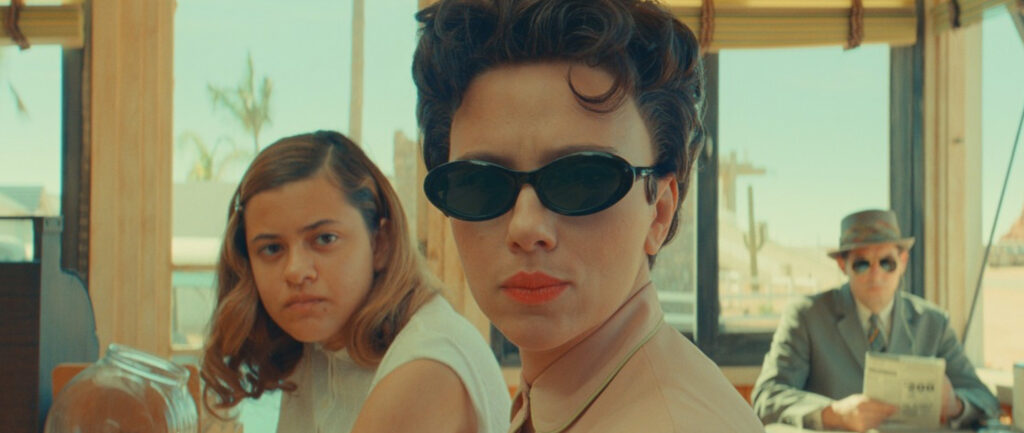
Q: Hope, you’ve worked in theater. Does this experience feel like a blend of it all? Does it feel more theatrical than most other film and TV experiences?
Hope Davis: The piece that feels theatrical is that it feels very loose, the way my early days in the theater felt, especially when we were rehearsing that scene, we were waiting for Tony Revolori to come. And so you jumped in for Tony… We were all jumping around in the desert with air guns in our hands and it had that kind of looseness. Movie-making can be very slow and dull, and this just felt so alive, so playful that it reminds you why you got into it in the first place.
Wes Anderson: Like when you’re doing a play, does it tend to start with nobody knows where they’re going to go? And it’s more like you’re just there with a text and people?
Hope Davis: You’re finding it in the moment. Some people come in, know all their lines and know where they want to go. But most of us are finding it as you go and I feel like we have the freedom to do that, but we had the animatic in our heads. So we knew we knew what the frames were going to end up being. When you were trying to get me into position in the doorway, when we were talking, it’s like I knew exactly where because I saw it. Yes. Do you ever release those Animatics? They’re so great.
Wes Anderson: I remember Maya standing a certain way for this scene. I was like, “That’s a good way. Like, “Well, that’s how you drew it…”
Q: Jeffrey, in a recent profile, you said you like working with Wes because he pushes you in the best way. Can you give an example of how he does that?
Jeffrey Wright: I’ll give an example. It may not be the one that might be expected. You do inserts in films and usually we’re at the inserts and it’s about 5 or 10 minutes, a couple of shots, boom of the inserted object and then you’re gone. We did an insert in this film of a moment in which my hand touches the holster, flips up the flap and grips the weapon — that took about 60 takes, four hours. And I now understand why.
Obviously, it’s not a performance thing for me, but it was really about trying to find a certain cleanliness to the thing that we couldn’t quite achieve until… I’ll give away a little family secret. We had a prop guy standing to my left, the lens here to my right, my body hiding him. So I flip up the flap on the holster and the prop guy puts his finger on it, keeps it up, the camera, the frame, is below his finger and then I slide my hand down and it works. It was really like an equation that we had to figure out and we figured it out and it was the wildest, strangest thing. I loved finding that the answer for that was shooting something else. Roman was shooting this stuff and we were reporting back to Wes. Then finally we just cobbled [it together].
Scarlett Johansson: You should have called me, I’m great at inserts. That’s my thing. I would have been behind the prop guy and held him.
Wes Anderson: Well, I’ll tell you what the problem was that there was no flap in the cartoon. That messed us up.
Jeffrey Wright: It is. But you look at it and it makes sense. There’s a cleanliness to it, you know.
Jason Schwartzman: May I say it’s a testament to show you that when we all get to collaborate and be supportive, these scenes are sometimes many things going on and many things to be a place for a take to work. But also, the crew is doing a lot. They have to just hit the marks exactly as much as they can. I remember after one take, the crew were all hugging since they got a good one because of this thing with the camera at the zoo and a light. I was like, that’s in because we’re all in it.
Jeffrey Wright: There’s a sense that everybody’s in it together and they’re just trying to find this little thing that might be magical. And then in this case, we had a pretty good laugh about it.
Q: This was shot in Spain under pandemic conditions. But it sounds like there is an extraordinary collaborative spirit to the set and that extends to the crew, and extends beyond what you’re shooting to fraternizing at night and just being in each other’s company. Scarlett, how would you describe to an actor that’s going to work with Wes, what’s unique about the Wes Anderson experience?
Scarlett Johansson: What’s unique about it I think, is that we’re all circling the same thing as to that sense of camaraderie that you have. That’s one of the things that really touches me about the movie — I think Stephen mentioned it too. It was how supportive all the performances are of one another in this way. It’s very noticeable in a way. That’s something about it that feels that way maybe because we’re all inside it. Of course, every performance stands out, They make this beautiful sort of orchestra with the pieces all together— that’s how it feels on the set.
When I got there, my work was truncated into a short period of time and I couldn’t have done it without having my scene partner Jason there. He was immediately available. It was just like falling into this comfortable pocket. You know, and I think that feeling is just very unusual. As Hope said, a lot of time you’re on set and it’s a lot of, you hear it all the time, that waiting and down time and you lose momentum and it makes you question what you’re doing with your life and everything. This doesn’t have that at all. It’s so vivacious and feels so exciting. Just to be actors coming on the set to just to watch other actors performing. It’s just a very unique experience for a film.
Q: Rupert and Maya, talk about the importance of a screen partner. Let’s hear about your collaboration and how you established what you needed to do in this film.
Rupert Friend: There was so much freedom in that as well. One of the things we talked about a lot was that Wes wrote one of his more succinct stage directions in the scene where we have our musical number and it just said, “They dance.” That was it. We kept saying, “When’s the choreographer coming? When is the rehearsal?” And it was like, “Oh, yeah.” Another time that we got there, we hadn’t had any of that and it was just, “Go for it” and [there was] that feeling of exuberance. I remember it was actually an amazing moment. I don’t know if you saw this but when we did that thing, I threw my hat in the air and behind the camera that day. Bill Murray had come to visit the set and he caught it and it was just perfect.
Maya Hawke: I think everyone’s sort of saying this, but Wes just cut all the fat and ridiculousness out of the movie-making process. Many times, when you have a scene partner, you have to establish a bond, you have these chemistry reads and it’s like we’re all going to need to talk and you guys need to get to know each other. instead we look, why don’t we just have dinner every night together, you know, wouldn’t that be fine? Actually you guys are off tomorrow and you should go for a walk and we just did and went for a bicycle ride. So often you’re on hold when you’re doing a movie. So you get brought in and sit in your trailer and wait.
Wes has fixed that, but you’re just always on hold 100% of the time. But you don’t feel like you are because he’s taking you out to this magical, wonderful place where you get to be engaged in other people doing their work. I remember sitting and watching Scarlett and Jason do incredible scenes between that window and I would come and sit next to Roman at his little monitor and watch them. After a little while, Adrien would come over and he’d be sitting there too and we were all engaged in the movie as a whole. It never felt like, “Oh, this is my part, this is your part.” It always felt like everyone was lifting each other up and that built chemistry really quickly and easily.
Tom Hanks: Those old movies about Hollywood where they’re on the lot. And somebody says, cowboy and there’s a showgirl and there’s a Roman Gladiator and there’s a guy dressed up like Charles [Chaplin]. That’s what it’s like hanging around, getting ready to work. We’re all in our costumes all day long. We’re all dressed in these different things and we’re all on hold ready to go to work on a set that’s incredibly focused and concentrated.
Jeffrey Wright: Basically, you’re trapped.
Hope Davis: You’re trapped but You want to be trapped
Adrien Brody: We all stay in the same hotel And then Wes will say, oh, we got to go and several of us will hop on a golf cart with Wes fully dressed in character. And so there’ll be an alien and a cowboy, showgirl and children hanging off the back. But we kind of make our way with a golf cart on the edge of this road through town, through Spain and arrive upon this magnificent set that is just mind blowing. It is just as spectacular as it looks in the movie and shows up fully ready to roll and jump right into the scene and get cracking.
Wes Anderson: When you mentioned that we did it under COVID protocols, I realized, we’ve been bubbling our movies for 15 or 18 years. It really wasn’t that different from the usual. It works, it works.
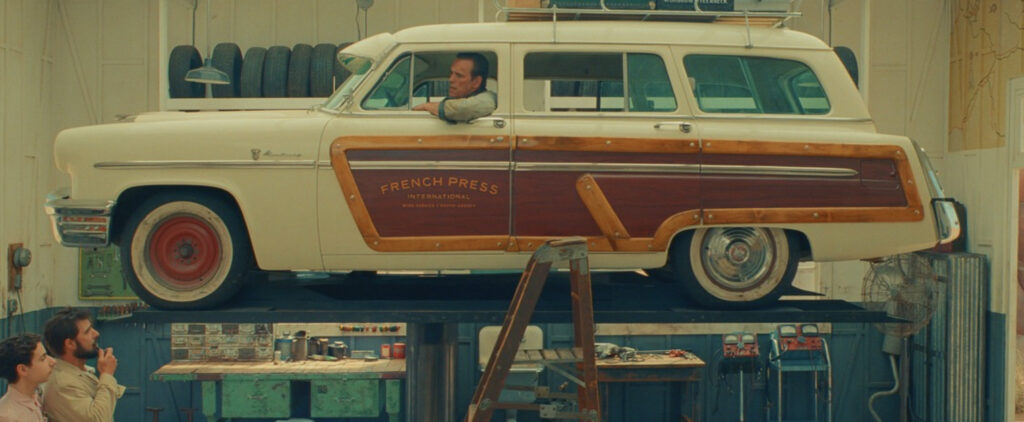
Q: There are so many folks here that have worked with Wes before and at different points in their career. Jake, for instance, “Moonrise Kingdom” was a bunch of years ago; now you’re at a different place in your life. Over 10 years ago, you made your Wes Anderson debut. How have you changed as an actor since then? What was it like coming back to work with Wes?
Wes Anderson: It’s worth mentioning that he was seven.
Tom Hanks: So puberty must have been something else.
Jake Ryan: After “Moonrise,” we kept in touch. You [referencing Wes] had me be a part of a bunch of different projects that you were working on at the time. I would like to think that I had matured a bit. And vaguely, I understood what I was doing at this point. So when I got the audition for this, you knew me, and I knew you guys kind of vice versa. I was just excited to reunite and after I got the part, I felt like I wanted to prove to myself that I’ve grown up a little bit.
Wes Anderson: The thing that struck me was because I have known you for so long, you probably, this is going to be Jake, but we still had people read — but Jake has done lots of other good work along the way. The particular thing was this scene, where you and Scarlett are on this train together and this scene wasn’t, I wasn’t really sure who it was even going to be this understudy. You see how he does fit in and you did that one from your record? I said, well, why don’t you do a video of this? You sent me the video and when I saw it, I was like, “Wow, he’s definitely mature.” You played it like an actor who’s taking a scene and interpreting it — in control of it. You were very, very good in that one.
Hope Davis: I remember last night when you were telling the audience, Moonrise Kingdom, you just, you just felt it was very cozy. You used the word cozy to be near Wes and to work with Wes and that, that kind of sums it up, that word. It is a very cozy feeling and that’s a very rare feeling in this business.
Wes Anderson: I will add also by the way that he was in his pajamas for almost that entire movie so it added to the feeling of coziness — all that flannel.
Jake: The temperature was always perfect — 71 degrees.
Q: Jason, your career is obviously linked forever with Wes. Thinking back to the first time you worked with him in “Rushmore,” what are the things you value most in this collaboration?
Jason Schwartzman: To know someone for a really long period of time and be able to work with them is really a rare and special thing. I think the one thing I value most about our relationship is that it seems like it’s sort of as it was when we first met. Like the second we met, we started talking about music and it was about sharing things that we were interested in.
I think that over the years we’ve been through so many different things, but there’s a fun when we come back and to share the things that you’ve experienced with someone that, you know and love and it’s about going off and having adventures and wanting to, It’s kind of like Halloween, like dumping out your stuff, seeing what you’re interested in. So when I read the script for this one, I’m alien, I’m catching up with my friend in a way too. I think fundamentally the idea is of enthusiasm and curiosity about something else being out there. That’s the fundamental thing of our relationship. Like any good relationship, the person grows and then brings it back.
Q: Wes, looking at this amazing cast, you’ve had here the most questions for you who picked your brain the most in a loving, wonderful way.
Wes Anderson: I don’t, I can’t, I’m not thinking of any questions.
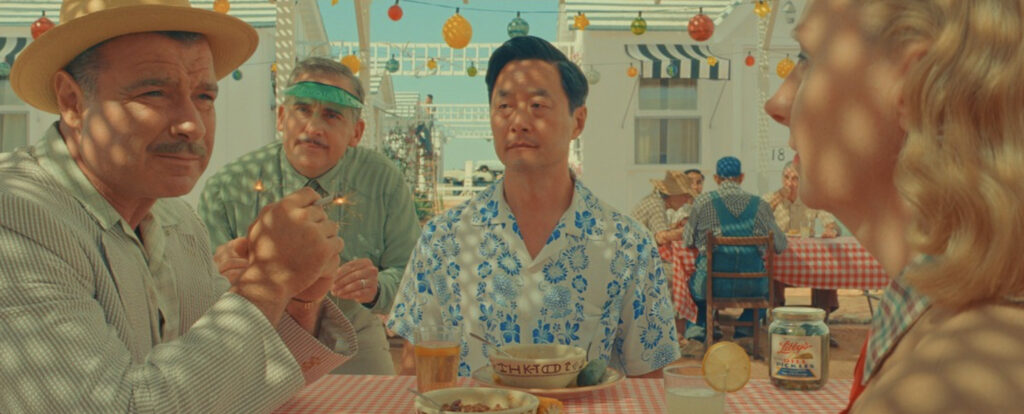
Q: Did anybody here read the script? Was it all self-evident? Again, you have the animatics, you have Wes but like, did you have any major questions after you read the script?
Bryan Cranston: What does it mean? It’s so specific and dense with detail that sometimes I have to read it a couple times to really get a sense of what we’re doing. This is a movie about a television show that’s doing an expose on a theater piece that in itself is a Russian doll sort of thing. Then there’s the actors who are also playing. So when you read that in script form, it can be a little daunting. So it was, it was illuminating to see the cartoon and extremely helpful. I would ask you, is that why you do that to share the storytelling or is it for you to know…
Wes Anderson: I think the reason I started, the way I started doing these cartoons — which I now feel we should/I should do — I said that we’d never talk about the cartoon to talk about the car. I explain the mathematics because I think it was from doing an animated movie. I must have seen a trillion animatics, you make this thing and you work from that and I realized that there were scenes that I had done that I would have completely messed up if I hadn’t done the scenes that I had. So I started using them more and more.
Doing them, it helps me, it also begins where we build the sets; we can only build what we can build. But if you know exactly what you’re going to shoot, then we can build something really big, we can build something with depth there. We aren’t going to be able to go much to the left or the right. But we can do something here this way and it is the start of how we build the sets but also it helps in the convenience. Sometimes I’ll say they were so good. We don’t need anything else. But if it’s in the cartoon, I’m required to shoot it. Usually I’m glad I did. There was a reason we put it in there and got the shot — or to get all the shots. Don’t just say it’s been done so well in this way that we’re just going to let it be.
Tom Hanks: For the inductees to the Wes Anderson gravy train, the folks that were there for the first time, I wondered if we got to have ideas. I mean, do we get to like, come in and say, you know, I was thinking about this and we asked some of the veterans of it, do we get to like, say, you know, how about this? And they said, yeah, sure, sure, sure. And we would. But then you would say, well, we don’t have enough set to shoot that, you know, that would be something. But like there’s he, I found him to be just as flexible as anybody would be provided. You’re not, you know, going, going south so far out of the realm of what you’re doing.
Wes Anderson: Well, the first shot that we did together, I think you looked at the frame and you said, you know, over here I could be out there hitting chip shots, golf balls, great. It was amazing. There’s a little place there and you went out to do that.
Tom Hanks: I called home right after that. “He took my idea!”
Q: For Adrien and Bryan, though both of your characters aren’t seen in the fictionalized reality of Asteroid City, both play important roles in guiding the story down a specific path. How do you feel about your characters taking on these narrative responsibilities?
Adrien Brody: I play the director of the play. Yeah, it’s funny to play a director. The actor always knows his place, there’s always the director and it just was really a special moment of the film because some part of what’s so beautiful about storytelling is for me. he said it, there’s a bit of nostalgia for this time and place of ’50s America and also of the West and cinema and a love for theater and the performances and the art of and the love for that, which is something that we’re all a part of. And that time in history was a big shift in the way acting was and how it was to directing actors like Marlon Brando and James Dean. So there was a chance to infuse some of that and a love for that and appreciation for that, which is, I’m sure, something that Wes appreciates very much as well. And so it was, it was really lovely to infuse all of that as a part of this vast storytelling.
Q: Bryan, you’re essentially our host as the narrator for this. It’s a unique responsibility.
Bryan Cranston: Whether you’re playing a lead part or a supporting role, you look for your slice. What is my kind of contribution to this story and in this exposition dialogue, to set up the structure of what the audience is about to see. mention all the names. There were a lot of names, a lot of interesting names that I had to get straight in my head. But I also thought I should be the one without any emotion. I should just be a blank slate so that people just listen and then follow along and try to key in and then hand off, just open up, introduce and hand off. I thought that was probably the best thing I could do more, something almost like a Rod Sterling or Ted Koppel’s voice kept coming, popping into my head. I think you hear it. I hear it anyway when I watch the movie for some reason, but some kind of established journalistic presence is what I was for you guys.
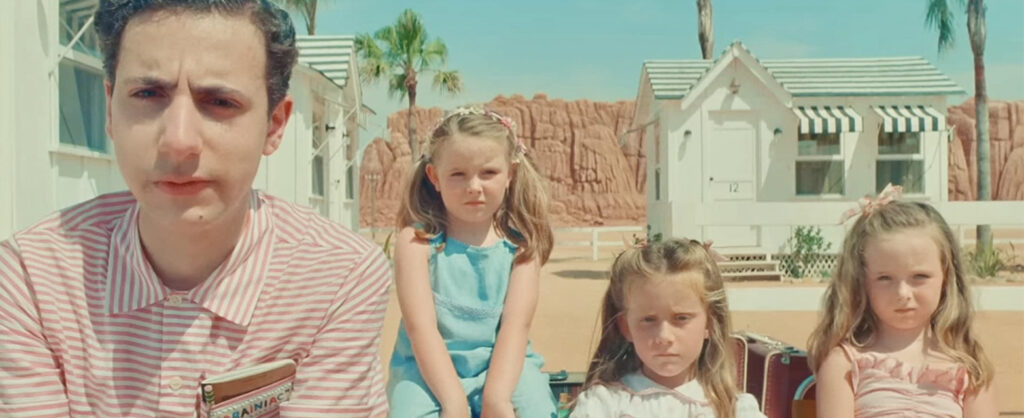
Q: Scarlett, were there any actresses who inspired you to build this character. And how did it feel playing an old Hollywood star?
Scarlett Johansson : Wes and I talked about it, we tried to figure out, to the others, to the old Hollywood Midge Campbell character. We shared some ideas about what type of a person this could be or what kind of career she could have had. Did she come from the actors studio and, you know, what did she sound like? And where, you know, kind of, I mean, I think we like, I like, I liked Bette Davis because I thought her career was a good shape and she felt like, you know, Bette Davis feels, I don’t know when you watch her, she seems comfortable in the space she takes up. so I felt like that could be a good beginning and, you know, and then listen to it and also her voice actually, and she has a little bit of that Mid Atlantic thing and understanding where that came from and, you know, all that stuff was helpful.
Wes Anderson: And yo,u like Bette Davis, said you’re comfortable in her space and it’s a space that she’s created in a voice that she’s cultivated. I invented one but she really owns it. It’s part of her because you have the scene you two have on the train together, you’re a different version of the character there than anywhere else in the hotel scenes. You’re both, you’re this actress and the role that she’s playing. There are lots of shifts around.
Scarlett Johansson: But the Midge Campbell one, I think we settled on that reference. Yes.
Q: Rupert, do you have a musical background? What was it like working with Jarvis Cocker and the cowboy band?
Rupert Friend: I don’t have a slide guitar, lap steel background. Right. Only in a very kind of campfire sort of way. when we asked if I wouldn’t mind learning this instrument and then playing it live with some of the musicians. I’ve been admiring my whole life. It was, it was a big daunting kind of gulp moment because you sit down to jam with Jarvis Cocker and Seu Jorge and the other two guys who are extraordinary musicians – they do this for a living and are incredible. I really was the odd man out. I don’t know whether it was deliberate Wes, but there’s something in what Wes says to me and I always feel that’s sort of a challenge, a bit of a dare and I love that.
Q: You have a background in sketch comedy. Does anything about working with? We compare to sketch.
Stephen Park: Comedy is much more competitive. There’s no competition here. It tends to be much more manic and extreme. It’s kind of extreme, everybody’s trying to push the envelope. This kind of set the parameters and we’ve seen the animatic and the script and everything. it’s much more, it’s cozy.It’s a much more kind of gentle nurturing. It’s comedic, we have so much fun and we definitely are going for, you know, something that’s light and fun and, and hopefully funny but I don’t know if I would completely compare it to sketch comedy. Yeah, it’s, it’s, it’s different. In sketch comedy also we’re usually in front of a studio audience or something. But yeah, If Wes says, “Ok, we’re done” and then maybe you’ll say one more for the pleasure, one more take. But after that, if Wes is happy, I’m like, “Wow, that’s great.” If he’s happy, then I’m happy.
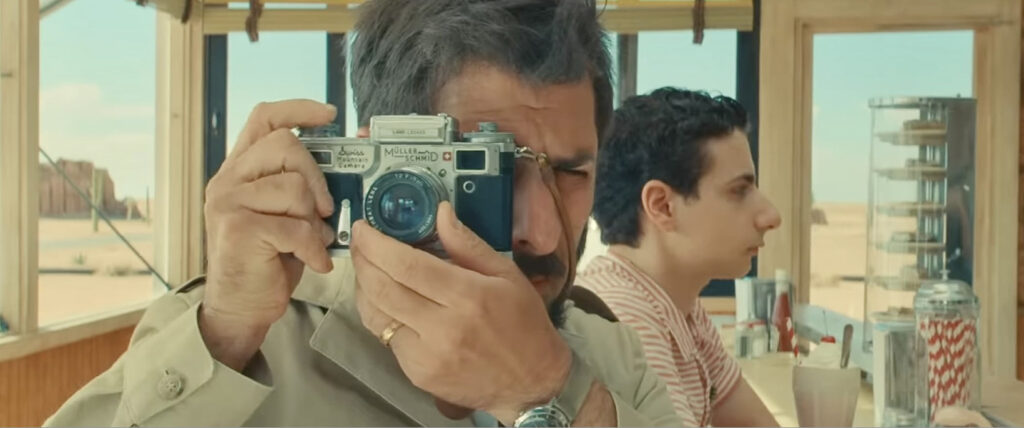
Q: Is that a Wes Anderson-ism– “one more for the pleasure.”
Wes Anderson : It’s from Barbet Schroeder. We did a scene with Barbet. He played a mechanic in a movie for a couple of three years ago — somewhere like that. I said, “Why don’t we have another go, it’s two.” So I know one more for pleasure. Six or seven. I was so scared by this.
Q: Who here loves their costume the most? How did your costume help you get into character?
Hope Davis: Well, as the regional head mistress Sandy Borden, perhaps that was the only title she will ever have in her life. My costume was everything on the page but when costume designer Milena Canonero put me in that costume, everything was decided. I just had to walk around in that costume. And there you see a housewife from the ’50s who is supposed to get all hot and bothered over getting a new washing machine. That’s the most excitement she’s ever had in her life. And this is all she has is this costume, but she wears it with pride. The costume and my wig did all the work.
Wes Anderson: I mean, you have authority when you wear that. Yes. The regional headmistress.
Hope Davis: I’m someone — the regional head. Yes. If only the Cookie Troopers are listening — that’s enough.
Stephen Park: I have to say though I had the simple Hawaiian shirt, but Milena must have looked at it for three or four hours making sure that the hems were correct and that it was exactly what she wanted and that kind of attention to detail made this simple Hawaiian shirt. Like, like I was wearing some kind of gold, you know, a diamond thing. She just elevated it by her attention to it.
Wes Anderson: I got your Hawaiian shirt. It got the Barry Lyndon treatment.
Tom Hanks: We’ll work up the courage to press Wes on something. But whatever Milena says goes, I’m not going to argue with Kubrick’s wardrobe person.
Wes Anderson: Also Milena doesn’t walk in alone, she has… We’re a small group. I always say we’re making a student film, even if we built a big set or something. We want it to be like 11 people or something in the middle of it. But when something involving a costume happens, there’s a large squad of Italians. And they answer to one person. Yeah.
Scarlett Johansson : And she never leaves work.
Wes Anderson: That’s the thing. Dinner is the dinners we all have together by the department heads because you can’t have so many people at dinner. Well, Milena doesn’t respect that. So when she comes in, she brings everybody but she arrives at dinner at midnight and you can’t really say anything when somebody arrives at midnight because they’re checking on the Hawaiian shirt.
Jeffrey Wright : She’ll occasionally say something when she’s fitting you, and this may be part of the reason that she brings her whole crew to you. She says Wes doesn’t like this but I like it and she’ll fight for that pleat or that particular cut.
Q: Wes, you manage to bring to life, the exploration of grief through a fantastical lens with this and “Darjeeling Limited” — both tend to bring humor to the plan. What is it about exploring grief in a colorful palette that appeals to you as a director and writer?
Wes Anderson: I don’t really think in terms of the color palette in relation to it, but I would say, that we have these milestones in our lives and particularly, as you get older. The dead begin to pile up and you go through this thing where you say, I cannot believe how often you say that the person who I would like to hear his or her point of view is this one [who is dead]. I just realized I’m never going to get the answer to this question — that starts to happen more and more. The power of these losses is among the two, at least that’s my experience. I guess we end up, you circle back to these things that you can’t quite find the answers about that you talk about with your friends and family.

Q: For Scarlett and Jason, both Augie and Midge come from very different environments and are able to forge this close bond that slowly grows stronger over time. How do you think your performances play into the idea of coping with grief in a constantly changing scenario? Is the subject of grief something like, are you playing the lines or are you playing the theme — do you talk about these kind of themes on set, about coping with grief?
Jason Schwartzman: You know, I’m still learning about the [character]. That’s one of the great pleasures of working in a film like this is sitting here with everyone and someone will say something and it’s totally beautiful new and Jake said something in an interview recently. I was like, how long have you known that? And why didn’t you tell me that when we were working?But I think with grief, you know, it forgives me this sense. My feeling is, or my experience is that like, it’s so cop.
There’s no, there’s no wrong way to feel if you’re grieving and that you should to, if you don’t feel sad when everyone else is sad, that’s ok. It’s worse to feel bad about not feeling a certain way that everyone is feeling. So you just feel the way you feel and that’ll be ok. Just trust that. To me, I didn’t think about that while we were doing it. But when I saw the movie and Adrien’s character said, “Just keep doing it to me. That’s what it is. It’s like, don’t feel bad, don’t worry about how you’re feeling, just feel it, it’s ok. Just go, keep going with this movement. That really kind of hit me and that’s when he said that.
Scarlett Johansson: It’s funny too because when we have the conversation about what connects us and there’s the enormity of my character saying, “I don’t want that feeling so I’m just going to not have it,” which is so convenient. If you’re an actor, it’s perfect. You just do not have that feeling in a race or whatever. Maybe you don’t want to either. That’s perfectly fine and that’s the world that she’s living in. You know, it’s not necessarily helpful for a father of four kids. But, it gives them both the kind of permission to be living just in the moment that they want to be in and that’s fine. You don’t have to feel obligated to feel like you have a moment they’re supposed to be having or whatever. I think they’re recognizing each other in that window of time.
Wes Anderson: Well, remember that we both looked at that Ingrid Bergman documentary and remember that her children are talking about her in a way. They loved her. They adored every minute they spent with her. But there wasn’t much. I don’t want to minimize the impression of the documentary. The time was very limited. She was away, she had whole other lives really. But the time she spent with them was totally focused on them.
Q: What’s the one that you’re going to hold dear the rest of your life from the experience of shooting Asteroid City? And it can’t be the six hours of insert shots – try for something more positive than that.
Stephen Park: Watching Jeffrey go through his speeches was so entertaining because he’s like a master of the English language and just watching him deliver Wes’s speeches in front of little kids was really entertaining.
Wes Anderson: Can I mention one thing about the process? Can I describe how that happened in two phases? Jeffrey arrived late night and the next day he’s shooting rather long paragraphs in one take with a lot of blocking. We did a lot and it was good, but it was sort of like the part was written for him. I’ve seen him on stage, I known how he can do it and we did it —we kind of hedged a bit with some other shots and then it was a rehearsal the next day. I said, “You know, it was good. It was maybe two days — you want to do it again?” He said “I would love to” and we went back on set the next day and a half and later on Saturday morning, set it all up. Exactly the same one take. That’s what’s in the movie. He just did it and everybody applauded it. It was like everybody was there anyway.
Jeffrey Wright: One take, two days.
Tom Hanks: Look, it’s a very convivial atmosphere that we all are very much attracted to. But that’s the secondary experience. The work that we do on the set is incredibly focused and there’s nobody who works harder at me than Wes and no one because Wes doesn’t walk away saying no, that’s good enough. Let’s talk about those three little girls that were like wrangling bats for Wes and that devoured the first 47 days of shooting. By the time we got there, some of us were thinking, “Well, he’s exhausted by those kids.” So we’ll be able to skate. But no, no, no, he is incredibly focused and concentrated and we look — it is 60 takes in order to get down. I had a big scene with Jason. He said, “Yeah, you like to do a lot of things because we don’t like take 17 and going on.” And I said, “Yeah, I do because we get to start at the beginning and go all the way through and we get to work on the whole thing.” I know a lot of guys who by take three think they are the truth we’re looking for. Then we move on. But that’s not the case here.
Scarlett Johansson: I remember.
Check out more of Nobuhiro’s articles.
Here’s the trailer of the film.

